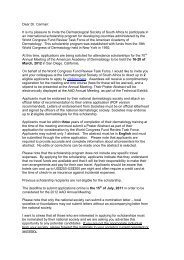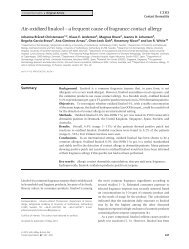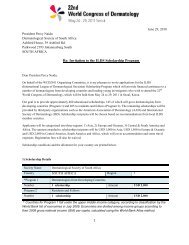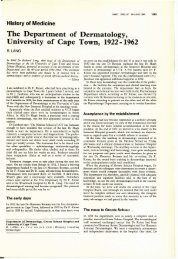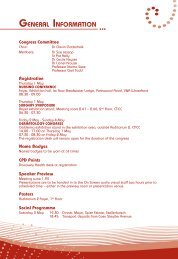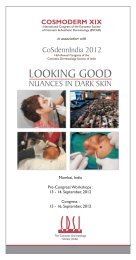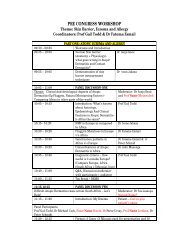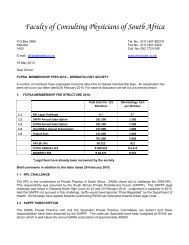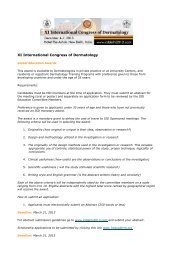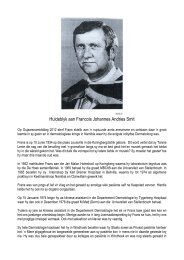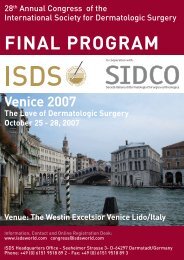Guidelines on the Management of Atopic Dermatitis ... - Dermatology
Guidelines on the Management of Atopic Dermatitis ... - Dermatology
Guidelines on the Management of Atopic Dermatitis ... - Dermatology
You also want an ePaper? Increase the reach of your titles
YUMPU automatically turns print PDFs into web optimized ePapers that Google loves.
serves a useful purpose for <strong>the</strong> clinician. Much energy has been needlessly wasted in<br />
debating which term should be used. Geographically <strong>the</strong>re is unexplained preference for <strong>on</strong>e<br />
or <strong>the</strong> o<strong>the</strong>r. The word “eczema” tends to be used more as a layman‟s term and “dermatitis”<br />
more in <strong>the</strong> scientific c<strong>on</strong>text.<br />
Eczema/dermatitis is not a diagnosis. The most comm<strong>on</strong> forms <strong>of</strong> eczema/dermatitis are<br />
atopic, seborrhoeic, primary irritant, allergic c<strong>on</strong>tact, photoallergic, phototoxic, nummular,<br />
asteatotic, stasis and dyshidrotic. Eczema/dermatitis associated with infecti<strong>on</strong> (e.g.<br />
dermatophyte) or infestati<strong>on</strong> (e.g. scabies) – <strong>the</strong> so-called “ide” reacti<strong>on</strong>s – are additi<strong>on</strong>al<br />
variants.<br />
“Atopy” comes from <strong>the</strong> Greek “atopos” meaning strange or unusual. In 1892, Besnier was<br />
<strong>the</strong> first to describe <strong>the</strong> associati<strong>on</strong> <strong>of</strong> atopic dermatitis with allergic rhinitis and asthma. The<br />
term “atopy” was first coined in medicine in 1923 by two allergists, Coca and Cook. They<br />
defined atopy clinically as a proclivity to develop <strong>the</strong> triad <strong>of</strong> atopic eczema, allergic rhinitis<br />
and asthma. Patients whom <strong>the</strong>y c<strong>on</strong>sidered to be atopic possessed a distinctive antibody,<br />
which <strong>the</strong>y called “regain” or “skin-sensitising antibody”, because intradermal skin tests to a<br />
variety <strong>of</strong> inhalant allergens, e.g. trees, weeds, grasses, dust, moulds and danders, elicited<br />
wheals at sites <strong>of</strong> some injecti<strong>on</strong>s. When Hill and Sulzberger in <strong>the</strong> early 1930s encountered<br />
atopic patients with skin lesi<strong>on</strong>s that favoured antecubital and popliteal fossae, <strong>the</strong>y initially<br />
called <strong>the</strong> disorder “neurodermatitis <strong>of</strong> atopic type”, <strong>the</strong>n “atopic eczema” and finally “atopic<br />
dermatitis”.<br />
In <strong>the</strong> 1980s, Hanifin and Rajka proposed a list <strong>of</strong> criteria, and unity in <strong>the</strong> clinical c<strong>on</strong>cept <strong>of</strong><br />
atopic dermatitis was established. In 1994 <strong>the</strong> UK Working Party refined <strong>the</strong>se criteria into a<br />
c<strong>on</strong>cise and validated set <strong>of</strong> survey-based diagnostic criteria useful for <strong>the</strong> purposes <strong>of</strong><br />
epidemiological studies (vide infra). The word “atopy” can be defined as “a clinical<br />
hypersensitivity state that is subject to hereditary influences; included are hay fever, asthma<br />
and eczema”. These c<strong>on</strong>diti<strong>on</strong>s develop against a complex genetic background: <strong>the</strong> socalled<br />
atopic dia<strong>the</strong>sis.<br />
The word “atopic” in <strong>the</strong> term “atopic eczema” is simply an indicator <strong>of</strong> <strong>the</strong> frequent<br />
associati<strong>on</strong> with atopy and <strong>the</strong> need to separate this clinical phenotype from <strong>the</strong> o<strong>the</strong>r forms<br />
<strong>of</strong> eczema which have o<strong>the</strong>r causes and distinct patterns. The terms “atopic eczema” and<br />
“atopic dermatitis” are syn<strong>on</strong>ymous.<br />
According to <strong>the</strong> positi<strong>on</strong> paper from <strong>the</strong> Nomenclature Review Committee <strong>of</strong> <strong>the</strong> World<br />
Allergy Associati<strong>on</strong> 3 <strong>the</strong> term “atopic eczema/dermatitis syndrome” (AEDS) should be used<br />
as <strong>the</strong> umbrella term to cover <strong>the</strong> different subtypes <strong>of</strong> AD. The new nomenclature (AEDS)<br />
underlines <strong>the</strong> fact that AD is not <strong>on</strong>e single disease, but ra<strong>the</strong>r an aggregati<strong>on</strong> <strong>of</strong> several<br />
diseases with certain clinical characteristics in comm<strong>on</strong>.<br />
Intrinsic AD (n<strong>on</strong>-allergic AEDS = NAAEDS, a.k.a. atopiform dermatitis) fulfils <strong>the</strong> most<br />
comm<strong>on</strong>ly used diagnostic criteria for AD. These patients have no associated respiratory<br />
diseases, such as br<strong>on</strong>chial asthma or allergic rhinitis, show normal total serum IgE levels,<br />
no specific IgE, and negative skin-prick tests to aeroallergens or foods. In <strong>on</strong>e study, intrinsic<br />
AD was more comm<strong>on</strong> in females and disease <strong>on</strong>set was later. Palmar hyperlinearity,<br />
pityriasis alba, recurrent c<strong>on</strong>junctivitis, and hand and/or foot eczema were uncomm<strong>on</strong>. The<br />
Dennie-Morgan fold associated positively with this type <strong>of</strong> eczema. This group comprises at<br />
least 20% (up to 60%) <strong>of</strong> cases 4 .<br />
Extrinsic AD (allergic AEDS = AAEDS) is comm<strong>on</strong>ly associated with respiratory allergies<br />
such as rhinitis and asthma, a high level <strong>of</strong> serum IgE, specific IgE and positive skin-prick<br />
tests to aeroallergens or foods. Immunological differences between NAAEDS and AAEDS<br />
can be found in <strong>the</strong> cell and cytokine pattern in peripheral blood and in <strong>the</strong> affected skin, and



